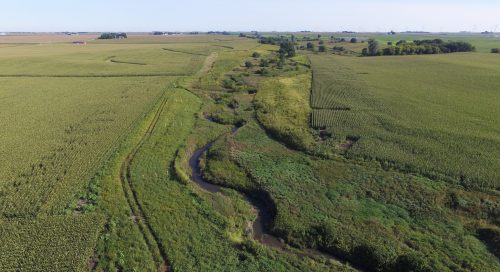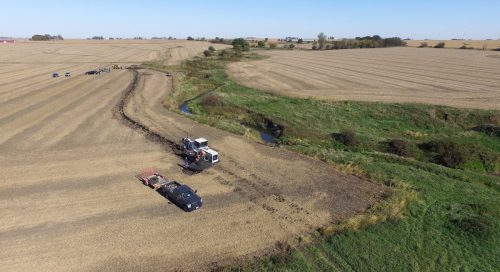In many ways, watershed management is relationship management. Strong connections and trust between watershed professionals, farmers, community members and groups, and local institutions are essential to implement the solutions for achieving the goals of a watershed plan.
This is why social capital matters in watershed management. Social capital is a community’s relational resources, the network and norms between individuals and groups. It is the glue that holds a group together, the threads that keep a community fabric strong and capable of collective action.
Watershed management projects are more likely to succeed in communities with high social capital. In fact, according to a report led by the North Central Region Water Network, it’s one of the necessary elements for scaling up watershed management in the Midwest.
But if you are working in a community with low social capital, how can you build it?
While there are no step-by-step instructions, understanding some basics about social capital will help. One key thing is focusing on strategies and activities that will support the four elements of social capital, as identified by scholars Jules Pretty and Hugh Ward: trust, reciprocity, norms or common rules, and connectedness.
It’s also helpful to know the distinction between the three types of social capital. Bonding social capital is close ties within groups of people with similar identities or values, such as between friends or neighbors, or even within a farmer-led watershed group.
Bridging social capital is connections between different groups or communities, such as between a farmer-led watershed group and a lakeshore owners association. While these connections may be weaker and interaction happens infrequently, bridging social capital is incredibly important for expanding opportunities and building community cohesion.
Finally, linking social capital is relationships across explicit, formal power gradients in a community, such as between a farmer-led watershed group and a government agency that funds it. This type creates access to resources or power that can support change-making processes and activities.
Here are five things any watershed leader could do to accrue social capital to support their watershed project.
Own your role as a connector.
It takes human capital to build social capital, and watershed leaders play essential roles as connectors and network builders. Make the time to reach out to and meet the people who could make important contributions to your watershed effort. And you don’t need to invest heavily in every connection – in fact, research shows that more loose ties mean more social capital.
Owning your role as a connector also requires a little bit of self-awareness, particularly around your own interpersonal skills. Not everyone is a social butterfly, and that is okay. You don’t have to be outgoing to develop meaningful working relationships with people. If you feel something is holding you back from networking with people, try to identify what that barrier is and focus on ways you could overcome it.
Map your relational assets.
Asset mapping is a tactic for identifying a community’s strengths and assets that can help it solve problems. Employ this method to identify the individuals and groups who could be relational assets to your watershed project.
Taking this approach helps you be strategic with your relationship building, allowing you to focus on making the ties that will be critical to achieve the goals in your watershed plan. Consider creating your relational asset map with collaborators on your watershed plan, so you can reap the benefit of your collective knowledge about the people in your watershed.
Create opportunities that strengthen networks.
Building social capital is about creating opportunities for people to connect with and feel connected to each other. One way you could strengthen networks is by providing spaces or opportunities for sharing information, stories, or resources.
For example, organize bridging events that enable otherwise un-connected groups, such as farmers and lakeshore property owners, to share their stories with each other. Or facilitate an opportunity for dialogue between a community group and leaders from a public or private institution about an important issue in your watershed.
Creating opportunities for exchange and communication cultivates reciprocity and transparency, which can help build trust. And trust is the oil in the engine of collaboration.
Invite people to participate.
Successful watershed projects often follow a participatory approach, meaning community members are involved in identifying the problems, strategies, and solutions. And it’s important to invite community members to participate in your watershed project early and often to ensure their voices are heard, their local knowledge is considered, and they develop a sense of ownership around the project and its outcomes.
That said, inviting participation is more successful in communities with a high level of readiness to participate. You know a community is ready when its people recognize there is a problem with water quality or quantity, they are motivated to fix it, and there is agreement on a solution. Prioritizing projects with high community readiness will increase chances of success.
If there is low community readiness, a starting point to participation may be to do a bit of community organizing to raise awareness about the problem and spark motivation to act. It will also be important to work with community members to define the issue in a way that makes sense to them and feels winnable.
Celebrate the small wins.
Speaking of winning, celebrating the small ones may be important to maintain social capital. It is easy to become overwhelmed by the enormity of challenges like degraded freshwater or climate change vulnerability, or to get discouraged when your efforts are falling short of your goals.
By celebrating the results that are visible – such as cooperation between two groups that had previously never interacted before – you can maintain motivation among community members to keep working together.
If you are part of a watershed management project, what have you done to build social capital in your watershed? Share your story in the comments!
Want to geek out about social capital? Here are some resources I used to write this post, and there are certainly many more out there.
- Successful Watershed Management in the Midwest: Getting to Scale by Amulya Rao and Rebecca Power
- Strategies for Building Social Capital by James R. Cook.
- Social Capital Research, a research and consulting organization
- Social Capital and the Environment by Jules Pretty and Hugh Ward
- Building trust in communities by University of Minnesota Extension
- Build Your Social Capital and Build Your Community by Tammy Day of the Nebraska Community Foundation
- What is Social Capital and How Do You Build It? by Heather Keam of the Tamarack Institute
Header photo: Tim Youngquist of Iowa State University (left) with Larry and Margaret Stone at their prairie strips near Traer, IA. NRCS/SWCS photo by Lynn Betts.



